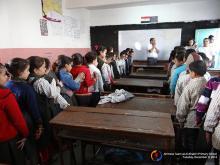On the International Day for Disaster Reduction, David Stevens from the United Nations Office for Disaster Risk Reduction (UNISDR) and member of the Expert Advisory Group for the State of the World's Volunteerism Report 2018, talks about the scope for volunteer action under the Sendai Framework for Disaster Risk Reduction as a people-centred approach to strengthening resilience.
In March 2015 there was huge excitement as UN Member States agreed on the first of the three core 2030 development agendas - the Sendai Framework for Disaster Risk Reduction (SFDRR). The Framework aims for: “the substantial reduction of disaster risk and losses in lives, livelihoods and health and in the economic, physical, social, cultural and environmental assets of persons, businesses, communities and countries.” My organization, the United Nations Office for Disaster Risk Reduction (UNISDR) is now working to help countries implement actions under the Framework, whilst also building coherence between Sendai, the Sustainable Development Goals, and the Paris Agreement.
Perhaps what we can be most proud of, is that while building on the previous Hyogo Framework for Action 2005-2015, Sendai takes a massive step forward by thinking about how we tackle new risks that will emerge over the next 15 years and beyond. The seven Global Targets of the SFDRR move beyond reducing existing risks, to also looking at the prevention of future risk, and strengthening resilience to future disasters. This brings the disaster risk reduction (DRR) focus of the Framework much closer to the climate change agenda.
The SFDRR also acknowledges and harnesses the wide range of roles that volunteers can play in supporting risk reduction efforts around the world. So, on the International Day of Disaster Reduction, I’d like to share five facts about volunteering and the Sendai Framework:
1. Like the Hyogo Framework before it, volunteers are recognized as key stakeholders in the implementation of the Sendai Framework.
The SFDRR calls for ‘a broader, more people-centred approach to disaster risk reduction, and notes that governments should engage volunteers and others in the design and implementation of policies, principles and standards.’
Under Priority 1 of the Framework ("Understanding Disaster Risk") the role of volunteers in creating and sharing DRR knowledge and best practices is highlighted. Under Priority 4 ("Enhancing disaster preparedness for effective response and to “Build Back Better” in recovery, rehabilitation and reconstruction") the need to train volunteers to respond to disasters is acknowledged.
2. Community involvement is central to all successful DRR activities and volunteering can play a leading role in promoting participatory approaches.
Countries, regions and cities have already, in many cases, included relevant goals and targets in their Sendai implementation plans to make this a reality. But there are still gaps and challenges to ensure that this is not just a top down exercise.
Experience shows the need for volunteers, volunteering organizations, and community-based organizations to work with public institutions to provide specific knowledge and pragmatic guidance in the development and implementation of normative frameworks, standards, and plans for disaster risk reduction.
3. We know that there is still much to do to fully realize inclusive community involvement.
Recognizing that they are disproportionally affected by disasters, yet under-represented in decision-making processes, the need for greater leadership and participation of women, children, youth, persons with disabilities, indigenous people, and migrants is strongly recognised by the SFDRR as crucial for the effective implementation of local, national, regional and global DRR plans and strategies. Volunteering can enable these under-represented groups to play a more active role, contributing to increased awareness, more resilient communities, and a more inclusive culture of disaster risk prevention.
Local governments are encouraged to base their DRR strategies and plans on local communities’ needs, knowledge, and engagement. A key opportunity to aim for is the Framework`s Target E which is to substantially increase the number of countries with national and local disaster risk reduction strategies by 2020. Volunteers can play a key role in supporting local governments in this endeavour, including by ensuring that the voices of those furthest behind are there at all stages of planning, implementation and monitoring.
4. The 2017 Global Platform in Cancun highlighted that volunteerism continues to be a fundamental resource for resilience that needs to be leveraged and supported.
Following the World Conference in Sendai, member states again got together in Cancun, Mexico from 24 – 26 May 2017 for the Fifth Session of the Global Platform for Disaster Risk Reduction. The Chair`s summary from that meeting stressed again that volunteerism continues to be an important resource for resilience, singling out the critical role played by the International Federation of Red Cross and Red Crescent Societes in responding to crises. A number of other volunteer organizations, civil society organizations, and governments working with volunteers actively participated in the summit.
5. UNISDR is currently developing a Partnership Strategy for 2018 that involves volunteers.
The Sendai Framework, the SDGs, and the Paris Agreement all call for an all-of-society approach. The breadth of UNISDR’s partner engagement has been widely recognized and applauded, however there is a need to step forward and do more with partners. An important first step is to develop a “Partnership Strategy” that will aim at professionalization, systematization, coherence, and sustainability. The goal is to develop and consolidate strategic partnerships to encourage and support broad stakeholder engagement in the implementation of the SFDRR. I hope that this will provide a dynamic platform for volunteers, volunteering organisations, and other members of civil society to engage at a collaborative level in the implementation of the Sendai Framework.
This blog post is part of the SWVR 2018 project. To return to the SWVR 2018 web section click here.

